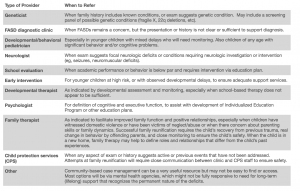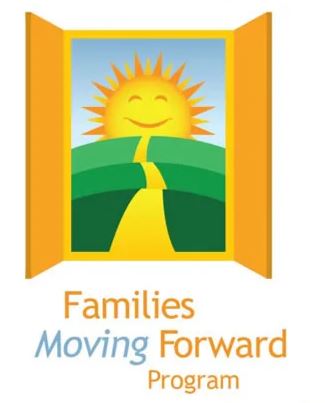
Although several diagnostic schemes are available for diagnosis of FASDs, all 4 diagnostic schemes delineate 4 areas of consideration when evaluating for an FASD diagnosis: history of in utero alcohol exposure, dysmorphology, growth retardation, and abnormalities of the central nervous system (CNS). Despite minor differences for inclusion and exclusion at both ends of the spectrum among schemes, all provide excellent reliability and validity of an FASD diagnosis.
| Type of Provider | When to Refer
|
| Geneticist | When family history includes known conditions, or exam suggests genetic condition. May include a screening panel of possible genetic conditions (fragile X, 22q deletions, etc).
|
| FASD diagnostic clinic | When FASDs remains a concern, but the presentation or history is not clear or sufficient to support diagnosis.
|
| Developmental/behavioral pediatrician | Especially in younger children with mixed delays who will need monitoring. Also children of any age with significant behavior and/or cognitive problems.
|
| Neurologist | When exam suggests focal neurologic deficits or conditions requiring neurologic investigation or intervention (eg, seizures, neuromuscular deficits).
|
| School evaluation | When academic performance or behavior is below par and requires intervention via education plan.
|
| Early intervention | For younger children at high risk, or with observed developmental delays, to ensure adequate support services.
|
| Developmental therapist | As indicated by developmental assessment and monitoring, especially when school-based therapy does not appear to be sufficient.
|
| Psychologist | For definition of cognitive and executive function, to assist with development of Individualized Education Program or other education plans.
|
| Family therapist | As indicated to facilitate improved family function and positive relationships, especially when children have witnessed domestic violence or have been victims of neglect/abuse or when there concern about parenting skills or family dynamics. Successful family reunification requires the child’s recovery from previous trauma, real change in behavior by offending parents, and close monitoring to ensure the child’s safety. When the child is in a new home, family therapy may help to define roles and relationships that differ from the child’s past experiences.
|
| Child protection services (CPS) | When any aspect of exam or history suggests active or previous events that have not been addressed. Attempts at family reunification will require close communication between clinic and CPS staff to ensure safety.
|
| Other | Community-based case management can be a very useful resource but may not be easy to find or access. Most options will be via mental health agencies, which might not be fully responsive to need for long-term (lifelong) support that recognizes the permanent nature of the deficits.
|
Click here or on thumbnail below to download PDF Referral Chart

Additional Resources:
Fetal Alcohol Syndrome: Diagnosis, Epidemiology, Prevention, and Treatment
This Institute of Medicine (IOM) report describes the research and clinical basis for physical and neurodevelopmental domains affected by prenatal alcohol exposure.
Guidelines for Identifying and Referring Persons with Fetal Alcohol Syndrome
Diagnosing FASDs can be difficult because there is no specific diagnostic medical test, and a broad range of symptoms and signs are included under the FASD umbrella. There are a number of various methodologies on the Centers for Disease Control and Prevention Web site that can be used to assist in making the diagnosis of an FASD.
Fetal Alcohol Syndrome: Guidelines for Referral and Diagnosis
A primary goal of these guidelines is to provide standard diagnostic criteria for FAS so that consistency in the diagnosis can be established for clinicians, scientists, and service providers. The guidelines are based on state-of-the-art scientific research, clinical expertise, and family input regarding the physical and neuropsychological features of FAS.
FASD 4-Digit Diagnostic Code
The 4-Digit Diagnostic Code is a tool developed by Drs Susan Astley and Sterling Clarren at the University of Washington FASD Diagnostic and Prevention Network to assist in conducting a comprehensive diagnostic evaluation for individuals who experienced or are suspected to have experienced prenatal exposure to alcohol. The 4 “digits” in the code refer to the 4 scales that assess severity of key diagnostic elements of FASDs: (1) growth deficiency; (2) FASD facial features; (3) CNS (brain) damage/dysfunction; and (4) maternal drinking during pregnancy.
A Practical Clinical Approach to Diagnosis of Fetal Alcohol Spectrum Disorders: Clarification of the 1996 Institute of Medicine Criteria
This report presents specific clarifications of the 1996 IOM criteria for the diagnosis of FASD in order to facilitate practical application in pediatric practice.
Fetal Alcohol Spectrum Disorder: Canadian Guidelines for Diagnosis
The diagnostic process consists of screening and referral, the physical examination and differential diagnosis, the neurobehavioral assessment and treatment, and follow-up.
Credit / Sources
This article is from the American Academy of Pediatrics, and was published originally on their website.









